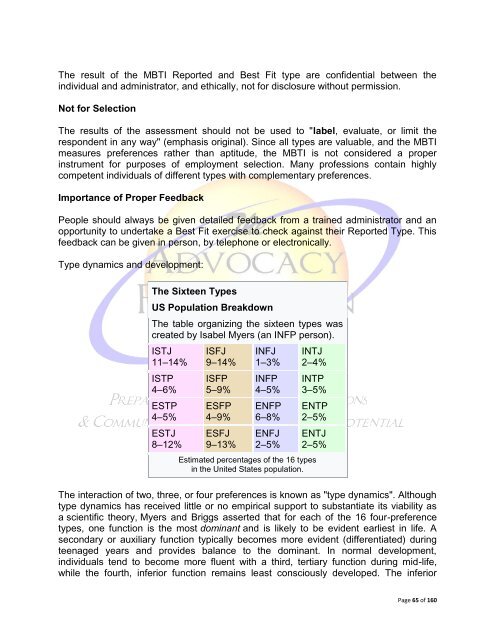The Gift of Introversion
The Gift of Introversion
The Gift of Introversion
You also want an ePaper? Increase the reach of your titles
YUMPU automatically turns print PDFs into web optimized ePapers that Google loves.
<strong>The</strong> result <strong>of</strong> the MBTI Reported and Best Fit type are confidential between the<br />
individual and administrator, and ethically, not for disclosure without permission.<br />
Not for Selection<br />
<strong>The</strong> results <strong>of</strong> the assessment should not be used to "label, evaluate, or limit the<br />
respondent in any way" (emphasis original). Since all types are valuable, and the MBTI<br />
measures preferences rather than aptitude, the MBTI is not considered a proper<br />
instrument for purposes <strong>of</strong> employment selection. Many pr<strong>of</strong>essions contain highly<br />
competent individuals <strong>of</strong> different types with complementary preferences.<br />
Importance <strong>of</strong> Proper Feedback<br />
People should always be given detailed feedback from a trained administrator and an<br />
opportunity to undertake a Best Fit exercise to check against their Reported Type. This<br />
feedback can be given in person, by telephone or electronically.<br />
Type dynamics and development:<br />
<strong>The</strong> Sixteen Types<br />
US Population Breakdown<br />
<strong>The</strong> table organizing the sixteen types was<br />
created by Isabel Myers (an INFP person).<br />
ISTJ<br />
11–14%<br />
ISTP<br />
4–6%<br />
ESTP<br />
4–5%<br />
ESTJ<br />
8–12%<br />
ISFJ<br />
9–14%<br />
ISFP<br />
5–9%<br />
ESFP<br />
4–9%<br />
ESFJ<br />
9–13%<br />
INFJ<br />
1–3%<br />
INFP<br />
4–5%<br />
ENFP<br />
6–8%<br />
ENFJ<br />
2–5%<br />
INTJ<br />
2–4%<br />
INTP<br />
3–5%<br />
ENTP<br />
2–5%<br />
ENTJ<br />
2–5%<br />
Estimated percentages <strong>of</strong> the 16 types<br />
in the United States population.<br />
<strong>The</strong> interaction <strong>of</strong> two, three, or four preferences is known as "type dynamics". Although<br />
type dynamics has received little or no empirical support to substantiate its viability as<br />
a scientific theory, Myers and Briggs asserted that for each <strong>of</strong> the 16 four-preference<br />
types, one function is the most dominant and is likely to be evident earliest in life. A<br />
secondary or auxiliary function typically becomes more evident (differentiated) during<br />
teenaged years and provides balance to the dominant. In normal development,<br />
individuals tend to become more fluent with a third, tertiary function during mid-life,<br />
while the fourth, inferior function remains least consciously developed. <strong>The</strong> inferior<br />
Page 65 <strong>of</strong> 160

















